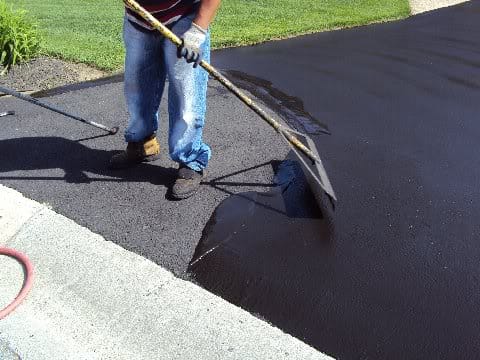Enhance Longevity: Warm Mix Asphalt Sealing for Angled Parking Frameworks
Enhance Longevity: Warm Mix Asphalt Sealing for Angled Parking Frameworks
Blog Article
Warm Mix Asphalt: A Lasting Remedy for Pavement
Warm Mix Asphalt (HMA) has actually arised as a leading sustainable selection for pavement options, providing a myriad of ecological benefits and cutting-edge innovations. As the demand for green building and construction methods expands, discovering the subtleties of HMA's sustainability can provide valuable insights into the future of pavement services.
Environmental Advantages of Hot Mix Asphalt

In Addition, Hot Mix Asphalt aids to mitigate city heat island impacts. Its dark color takes in sunshine, decreasing the quantity of heat mirrored back into the environment contrasted to lighter-colored pavements. This can decrease ambient temperatures in metropolitan locations, reducing the demand for air conditioning and ultimately lowering energy usage.
On top of that, Warm Mix Asphalt adds to boosted stormwater management. Its porous nature enables water to penetrate the sidewalk and reenergize groundwater supplies, decreasing overflow and the danger of flooding. These ecological advantages make Warm Mix Asphalt a lasting selection for leading freeways and roadways.
Power Effectiveness in HMA Manufacturing
Is power performance a crucial consider the production of Warm Mix Asphalt (HMA)? Definitely. Energy plays a substantial duty in the manufacturing of HMA, influencing both price and ecological sustainability. One vital aspect of energy effectiveness in HMA manufacturing is the usage of cozy mix asphalt (WMA) modern technologies (commercial parking lot paving). WMA enables the blending and positioning of asphalt at lower temperature levels contrasted to typical warm mix asphalt, leading to decreased energy consumption throughout manufacturing. This procedure not only decreases gas use yet likewise lowers greenhouse gas emissions, making it a more eco-friendly alternative.
Furthermore, innovations in plant innovations have brought about even more energy-efficient HMA production procedures. Modern plants are developed with attributes like recycled asphalt pavement (RAP) processing abilities, effective burner systems, and enhanced insulation, all contributing to power savings. By optimizing power usage in HMA manufacturing, the market can lower its carbon footprint while keeping high-grade pavement products. Energy effectiveness is, therefore, a critical consideration in making certain the sustainability of Hot Mix Asphalt manufacturing.
Recyclability of Warm Mix Asphalt
The recyclability of Warm Mix Asphalt (HMA) is a critical facet of its sustainability and long-term environmental effect. HMA is just one of one of the most recycled materials in the United States, with over 100 million bunches of reclaimed asphalt pavement (RAP) being recycled each year in new sidewalk building and construction. Recycling HMA provides numerous ecological benefits, such as minimizing the need for virgin materials, go to website reducing power intake during production, and decreasing the amount of waste sent to garbage dumps.
The procedure of reusing HMA entails crushing the existing sidewalk, squashing it into smaller sized items, and mixing it with new aggregate and asphalt binder to create a recycled mix. This recycled mix can commonly execute along with and even far better than conventional HMA, while requiring less basic materials and generating reduced greenhouse gas exhausts. By including RAP right into brand-new pavement projects, road agencies can conserve natural deposits, lower prices, and lessen the ecological footprint of road building and maintenance activities. Overall, the recyclability of HMA plays a significant duty in advertising lasting methods within the pavement industry.

Long-Term Efficiency of HMA
Asphalt sidewalks demonstrate durability and durability over an extended period, mirroring the long-lasting efficiency of Hot Mix Asphalt (HMA) In addition, advancements in HMA modern technology, such as the use of polymer-modified binders and cozy mix asphalt, have actually even more boosted the sturdiness and long life of HMA pavements. By focusing on quality building and upkeep practices, HMA continues to confirm itself as a sustainable and economical option for long-lasting pavement facilities.

HMA: Durability and Sustainability
Showing both sturdiness and sustainability, Hot Mix Asphalt (HMA) has actually ended up being a keystone in the building of lasting sidewalk infrastructures - hot mix asphalt. HMA's toughness comes YOURURL.com from its capacity to endure hefty tons, rough weather condition problems, and high web traffic quantities, making it a trustworthy choice for roadways, highways, and flight terminal paths. The structure of HMA, which typically consists of accumulations, binder, and filler, plays a vital role in improving its long life and resistance to damage
Moreover, HMA's sustainability hinges on its recyclability and energy-efficient manufacturing process. The capability to recycle reclaimed asphalt pavement (RAP) in brand-new HMA combinations decreases the need for virgin products and minimizes the environmental effect of sidewalk construction and maintenance. In addition, the power efficiency of creating HMA depends on its reduced blending temperatures compared to other sidewalk products, bring about pop over to this site reduced energy usage and greenhouse gas discharges.
Conclusion
In conclusion, hot mix asphalt (HMA) provides a lasting option for sidewalk with its eco-friendly features. HMA's recyclability, power efficiency in production, and long-term resilience make it a green selection for roadway building and construction. By preserving all-natural sources, lowering waste, and decreasing greenhouse gas exhausts, HMA plays a critical duty in advertising sustainability in facilities advancement. Its capability to alleviate metropolitan warm island effects further underscores its importance in developing resistant and eco mindful sidewalk systems.
HMA is one of the most recycled products in the United States, with over 100 million lots of reclaimed asphalt sidewalk (RAP) being reused annually in brand-new pavement building and construction.The procedure of reusing HMA entails crushing the existing pavement, squashing it into smaller pieces, and blending it with new accumulation and asphalt binder to create a recycled mix.Asphalt sidewalks demonstrate resilience and resilience over a prolonged period, showing the long-term efficiency of Hot Mix Asphalt (HMA) Furthermore, developments in HMA modern technology, such as the use of polymer-modified binders and cozy mix asphalt, have additionally enhanced the toughness and longevity of HMA sidewalks. The ability to reuse redeemed asphalt pavement (RAP) in brand-new HMA mixtures decreases the need for virgin materials and lessens the ecological impact of sidewalk construction and maintenance.
Report this page